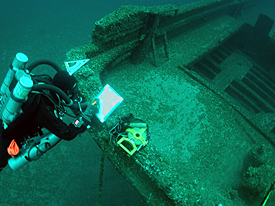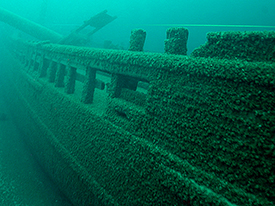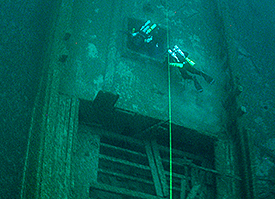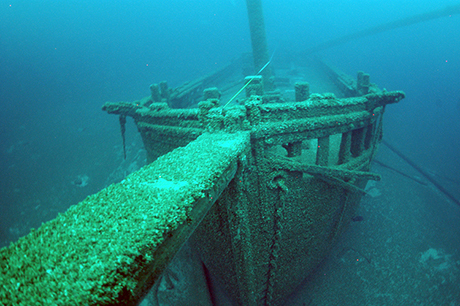
A Two-Masted Schooner-Rigged Canaller:
The Walter B. Allen
7 September 2010
By Matt Carter

A diver documents the stern area. Large View (photograph courtesy of Tamara Thomsen).
The Walter B. Allen is a two-masted schooner-rigged canaller. A canaller is a distinct vessel type which is unique to the Great Lakes - these vessels were built to exact measurements of the Welland Canal Locks. The Welland Canal allows ships to connect Lakes Erie and Ontario, bypassing Niagara Falls. Built in 1866 in Ogdensburg, New York, specifically, the Walter B. Allen was built to fit the second iteration of the Welland Canal locks. By building the vessels to this dimension, these boxy ships could carry the largest possible amount of cargo with only inches to spare within the lock. Canallers typically had bluff bows, flat bottoms and sterns, short bowsprits and highly canted jib booms. Some canallers were rigged with hinged jib booms or ones that could be folded, removed or de-rigged for passage through the locks. The mainmast (on two-masters) and mizzenmast (on three-masters) booms were typically shortened so they would not overhang the stern.

Exterior view of the port side. Large View (photograph courtesy of Tamara Thomsen).
The canallers would transport grain raised in the Midwestern heartland from Chicago, Illinois, and Milwaukee, Wisconsin, to eastern ports. The Walter B. Allen typically offloaded her grain at Buffalo or Oswego, New York. When she returned to Chicago she was with a load of coal from ports on Lake Erie and Ontario, used for heating the midwestern cities and powering steam-powered factories. Grain schooners, as they are also frequently called, could make the Oswego-Chicago round trip in thirty to thirty-five days and would complete six to seven trips over a season.

Looking down on two divers investigating the hatchway. Large View (photograph courtesy of Tamara Thomsen).
The Walter B. Allen is the third canaller surveyed by the Wisconsin Historical Society. This survey is adding to an ongoing study of unique construction features of this vessel type. Many of these features are only known to us through the archaeological record, so surveys like these contribute to our overall understanding. The canaller Kate Kelly in 65 ft of water off Racine, Wisconsin, was studied in 2003, and the Daniel Lyons in 125 feet of water north of Algoma, Wisconsin, was surveyed in 2005. Both of these vessels are broken and scattered on the lakebed. Because of the reasonably shallow depth associated with these sites they have experienced periods of looting. Comparatively, the Walter B. Allen is in 175 ft of water and is completely intact - due to the extreme depth of the site, much of the site's cultural material remains in place, making it a virtual time capsule of 1880 shipboard life. Additionally, the slow rate at which the Walter B. Allen sank has left her hull unmarred from the sinking process and many features remain as they did the day the ship sank.
Our survey consisted of one dive a day over eight days, with bottom times ranging between 45 and 60 minutes. These times accumulated upwards of an hour and a half of decompression obligation with an overall in water time of two and a half hours before surfacing. With bottom temperatures at 41 F, this made for a cold dive. Thankfully in July thermoclines appear at shallower depths in Lake Michigan making the extenuating decompression tolerable.

Bow view of the Walter B. Allen. Large View (Photograph courtesy of Tamara Thomsen).
Return to MUA Project Journals home page.

